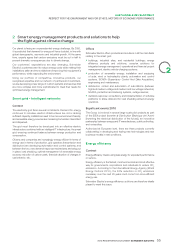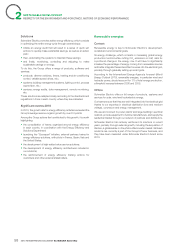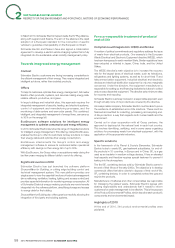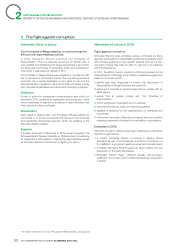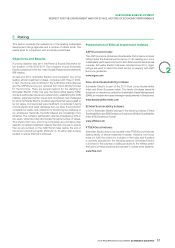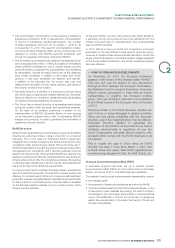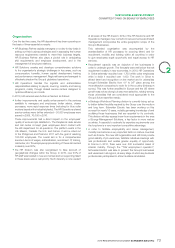APC 2010 Annual Report Download - page 66
Download and view the complete annual report
Please find page 66 of the 2010 APC annual report below. You can navigate through the pages in the report by either clicking on the pages listed below, or by using the keyword search tool below to find specific information within the annual report.
SUSTAINABLE DEVELOPMENT
2SCHNEIDER ELECTRIC’S COMMITMENT TOENVIRONMENTAL PERFORMANCE
2 Reduction of CO2 Emissions
Schneider Electric’s Approach
Schneider Electric is not subject to European quotas on carbon
emissions since it is an industrial business that globally produces
few emissions in comparison to energy intensive industries: the
main emissions from its activity come from purchases and logistics.
Schneider Electric is therefore classifi ed in the low emissions sector
by the Carbon Disclosure Project(1). However, the Group has defi ned
measures to reduce its carbon emissions.
In 2007, Schneider Electric asked an outside specialist to perform a
carbon assessment of its operations, from its upstream suppliers to
its downstream distribution chain. The assessment revealed:
•the major areas of carbon emissions (see diagram);
•the potentially very high impact of SF6 gas leaked into the
atmosphere from certain families of medium voltage equipment.
SF6 can be freed, in particular, when end-of-life equipment is
dismantled by companies who do not recover their waste.
5%
Sites’ energy consumption
40%
Logistics and
business travel
53%
Purchases
2%
Others
In the Planet & Society Barometer, Schneider Electric has set the
following objectives for 2009-2011:
•reduce its emissions of CO2 equivalent by 30,000 tons per year for
scope 1 and 2 as defi ned by the GHG Protocol(2): the emission
of SF6 in the industrial sites concerned and energy consumption
in industrial and logistics sites, and in some tertiary sites, as well
as part of scope 3 of the GHG Protocol (2): the portion of air-freight
in the long-distance freight mix (3). The objective is to reduce our
CO2 emissions by approximately 15% over three years.
•implement a recovery process for SF6 gas in 10 countries.
The fi rst devices containing SF6 gas sold by Schneider Electric
reached their end-of-life at the start of 2000. The aim is to
develop commercial offerings to encourage customers to collect
their devices containing SF6 which have reached their end-of-life
and to fully extract the gas for recycling (see “Specifi c solutions”
on page 59).
In 2010, Schneider Electric generated 66,067 tons less of CO2
equivalent than in 2009 on a like-for-like basis.
This good performance in relation to the objective of an annual
reduction of 30,000 tons of CO2 equivalent is mainly due to the
reduction of SF6 leaks in the production processes, thanks to:
•mandatory monthly reporting since mid-2010 rather than twice
a year in 2009;
•systematic risk analysis started on all European sites;
•process improvements in certain sites, in particular issuers.
CO2 performance linked to energy consumption in 2010 was
calculated based on a 2008 benchmark to “absorb” the effect of
the economic crisis in 2009, which saw a drastic fall in production
and the associated energy consumption. Furthermore, effi ciency
metering is impacted by the variation in temperatures which did not
change, as 2010 saw very harsh winters in the northern hemisphere.
Moreover, some of our more energy intensive sites saw signifi cant
growth in 2010, thus increasing their CO2 emissions.
Overall, in 2009 and 2010, Schneider Electric reduced its emissions
of CO2 equivalent by 110,156 tons and has therefore signifi cantly
exceeded its objective of a 30,000 ton reduction per year over three
years.
In 2011, Schneider Electric is working on defi ning its next objective
for the reduction of carbon emissions for the Planet & Society
Barometer in the Company’s next program. The Group’s approach
is based on measuring, controlling and reducing CO2 emissions,
starting with the most direct ones upon which the Group has most
impact and greater reliability in terms of metering (these correspond
to scopes 1 and 2 defi ned in the GHG Protocol) followed by our more
indirect emissions (corresponding to scope 3 of the GHG Protocol).
Schneider Electric publishes on its website (www.barometre.
schneider-electric.com, Environment section) its response to the
challenges posed by climate change, by responding to surveys
from the Carbon Disclosure Project (CDP) each year. This project is
a global initiative led by investors and asset managers. The CDP is
designed to help members make informed investment decisions by
explaining the consequences of the carbon constraint and climate
change for companies.
Schneider Electric CDLI and CPLI Score in 2010
Schneider Electric Score 2010 2009 2008
CDLI 52 60 69
CPLI B
(2) The Greenhouse Gas Protocol (GHG Protocol) is the world’s most widely used system for measuring CO2 emissions. Scope 1 covers direct
GHG emissions from sources that are owned or controlled by the Company. Scope 2 accounts for GHG emissions from the generation of
electricity consumed by the Company. Scope 3 covers all other indirect emissions from sources not owned or controlled by the Company
(transport, use of products and services, etc.).
(1) Source: Carbon Disclosure Project 2008, survey of French companies in the SBF120.
(3) Long distance freight comprises air freight and maritime freight.
2010 REGISTRATION DOCUMENT SCHNEIDER ELECTRIC64



